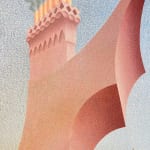Henry Orlik b. 1947
Framed H. 115 cm. x W. 88 cm., H. 45 1/4 in. x W. 34 1/2 in.
Further images
-
(View a larger image of thumbnail 1
)

-
(View a larger image of thumbnail 2
)

-
(View a larger image of thumbnail 3
)

-
(View a larger image of thumbnail 4
)

-
(View a larger image of thumbnail 5
)

-
(View a larger image of thumbnail 6
)

-
(View a larger image of thumbnail 7
)

-
(View a larger image of thumbnail 8
)

The title, pink colour and scale of the architecture of Win or Lose suggest Las Vegas and the older architecture of its famous hotels such as Caesar’s Palace, The Flamingo and the Bellagio. The looming buildings become a house of cards, suggestive of the impermanence of its desert setting and the ‘win or lose’ of gambling. The viewpoint upwards and odd angles of the buildings make them loom over the viewer as if they are tilting at a perilous angle. A trellis-like structure rises-up diagonally and through this can be seen clubs, diamonds and hearts as windows on the buildings. They are a pack of cards which could tumble at any moment.
The pink of the buildings suggests the pink stone of desert architecture, and this is punctuated by two green palm trees which lean towards each other, as trees or buildings. They become two connecting turrets which like hands, wearing green croupier gloves, deal out the cards; on closer inspection it appears the ‘arms’ are tied loosely together by twine or hair, behind the back or raised in surrender, like a scene from an old Western.
A rounded pink structure in the centre seems to have a moulded water-course emanating from it, as organic matter seems to surge or spew out towards the viewer like a distorted rendition of the famous swimming pool at the Flamingo Hotel, which has a backdrop of pink buildings, palm trees and skyscrapers. Organic-shaped hearts (freed from the restrictions of their cards) float out from beneath the dome, like leaves falling or butterflies flying. Perhaps these are the lucky ones, as they are the souls (butterflies are symbols of the soul) who have escaped to float away into the ether. Perhaps they also represent the imagination, which freed from its harsh, two-dimensional surroundings, floats free, endlessly replenishing itself, unreachable and unbound.
Four triangular ‘shadows’ appear on the wall of the skyscraper behind the trellis, reminiscent of the spikes on the Statue of Liberty and the tall pink tower to the left of the painting then becomes the arm of the Statue held aloft and the pink rounded building becomes her head. Here at the peak, though, instead of the ‘Flame’ of Liberty, waves of subtle grey polluting smoke pour out of the top of the canvas from seven incongruous chimney pots, almost invisible from the viewer. The green of the ‘hands’ is similarly suggestive of the green of the copper statue and they become the statue’s crown. Win or Lose becomes an analogy of The American Dream that can go either way – win or lose – for those who arrive there on (a figurative) Ellis Island.








